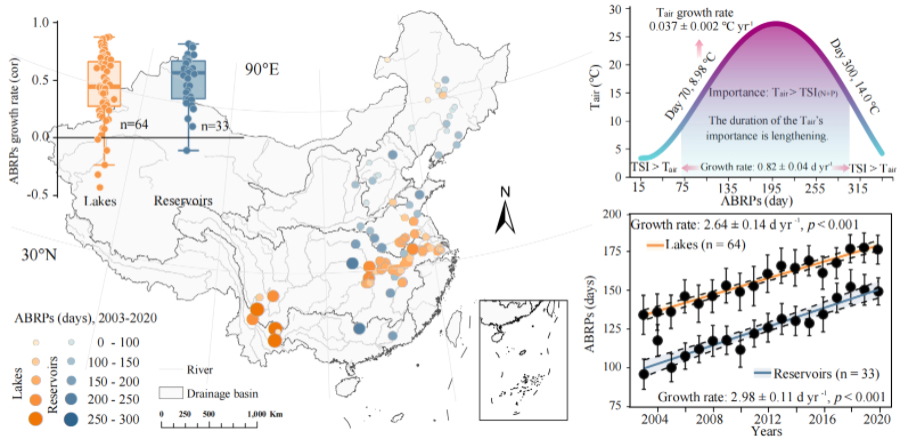In recent years, with the intensification of global climate warming, the issue of algal blooms(ABs) in lakes and reservoirs (L&Rs) has become increasingly prominent, posing a serious threat to aquatic ecological environment security and drinking water supply. Although China has implemented strict control measures for external nitrogen (N) and phosphorus (P) pollution, ABs in many L&Rs have not been effectively curbed, and the underlying driving mechanisms require in-depth research. To address this, Researcher Wang Jingfu from the team of Researcher Chen Jingan at the Institute of Geochemistry, Chinese Academy of Sciences, in collaboration with several leading institutions, conducted a quantitative study on the relative contributions of climate change and nutrient input to the risk of ABs in L&Rs. The aim is to provide a scientific basis for the precise prevention and control of ABs in L&Rs under new circumstances.
(1) Climate warming is the dominant factor prolonging the algal bloom risk period.
By integrating remote sensing monitoring, water quality measurements, and meteorological data from 97 key L&Rs across the country between 2003 and 2020, the study revealed the spatiotemporal patterns of algal bloom risk periods (ABRPs). The results show that over the past 18 years, the ABRPs in China's L&Rs has significantly extended, with lakes and reservoirs experiencing increases of 42 days and 54 days, respectively. Using an interpretable machine learning method for the first time, the study quantitatively determined that the contribution of rising temperatures to the extension of ABRPs reached 11%, far exceeding the contributions of TP (5.3%) and TN (3.5%). This indicates that climate warming has become the most critical driving factor for changes in the temporal patterns of ABs.
(2) Reservoirs are more sensitive to climate warming than lakes.
Based on deep learning neural networks (DLNN) and the SHAP factor interpretation model, the study found that reservoir systems are more sensitive to climate warming compared to natural lakes. The air temperature (Tair) threshold for algal bloom occurrence in reservoirs is significantly lower than that in lakes (12.6 °C vs. 16.7 °C), and the contribution rate of Tair factors is as high as 17% (compared to only 5% for lakes). This difference primarily stems from the deeper water bodies, stronger thermal stratification effects, and longer hydraulic retention times of reservoirs. These characteristics make reservoirs more prone to earlier warming in spring and delayed cooling in autumn, thereby significantly extending the window suitable for algal growth.
(3) Machine learning reveals nonlinear interaction mechanisms between climate and nutrients.
The research team integrated the DLNN-SHAP-RSF model framework to uncover the complex nonlinear relationship between Tair and nutrients in AB occurrence. The results show that Tair contributes more to ABs than nutrients for more than 67% of the year, and that this will increase with global warming. Predictions from the random survival forest (RSF) model show that under the current climate warming trend (0.037 °C yr-1), the impact range of temperature on AB timing is increasing at a rate of 0.82 days per year.

Growth trends of ABRPs in Chinese L&Rs and their controlling factors
Contact:
Wang Jingfu
Institute of Geochemistry, Chinese Academy of Sciences
Email: wangjingfu@mail.gyig.ac.cn
(By Prof. Wang Jingfu’s group)